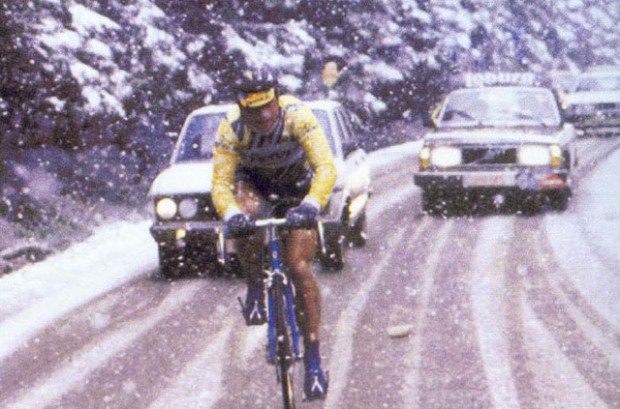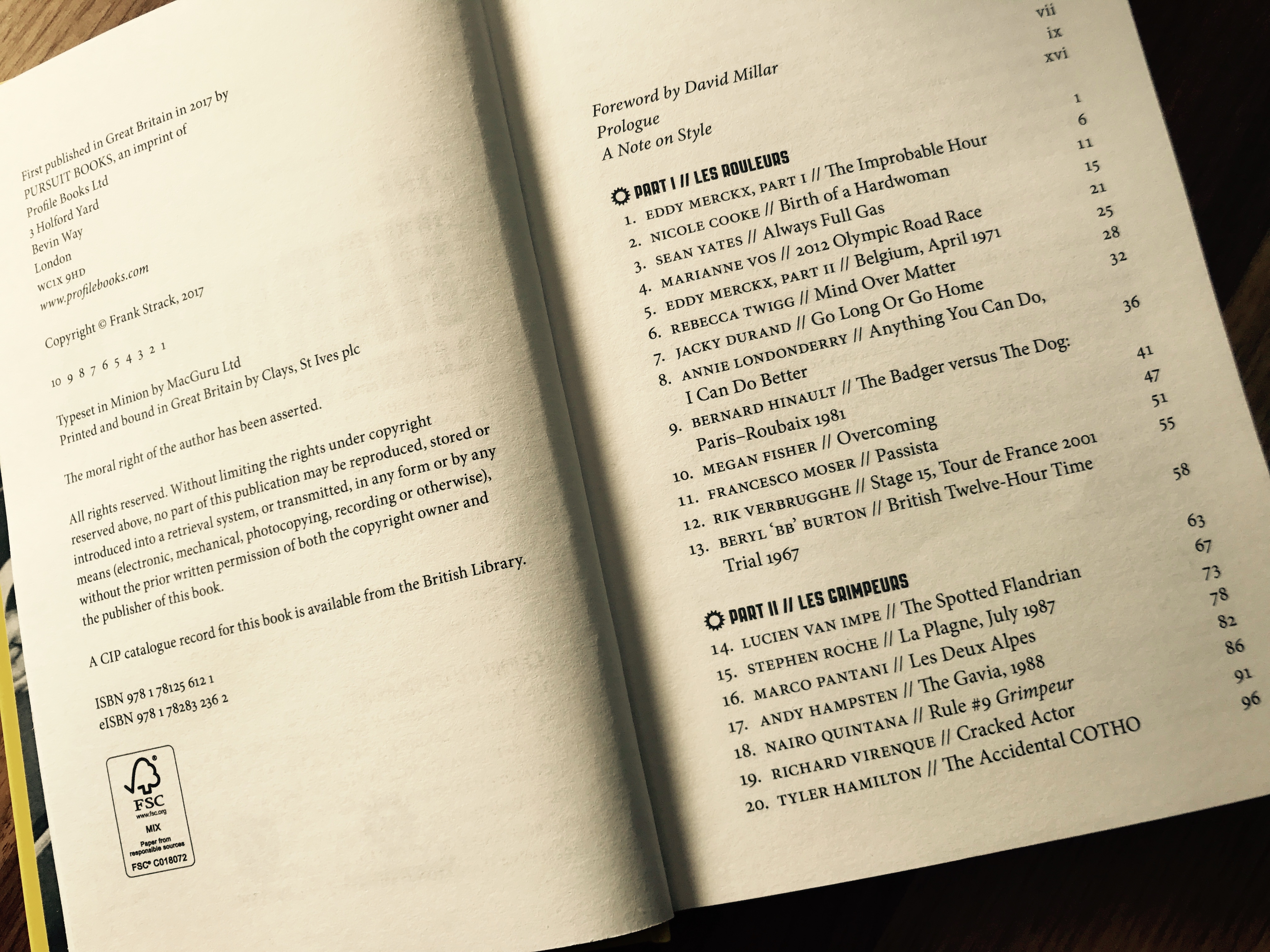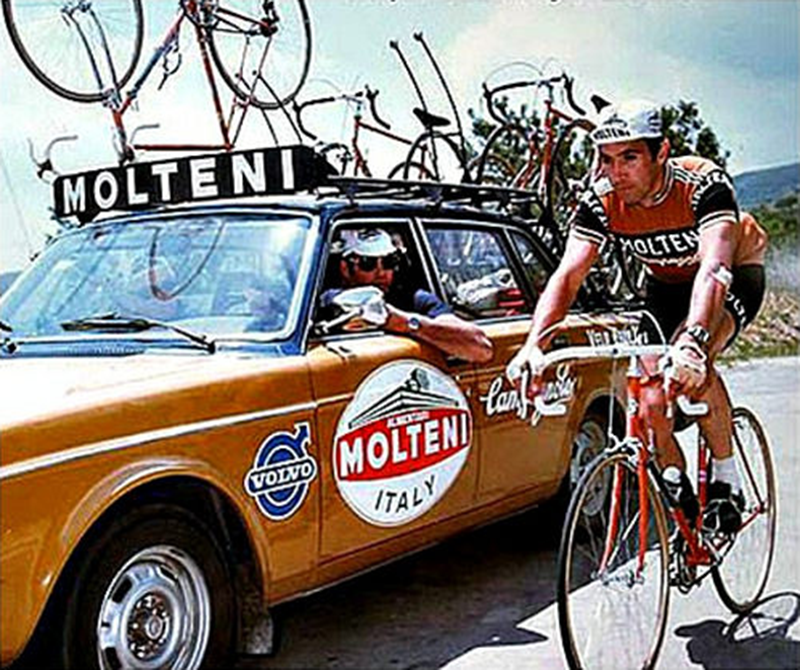Guest Article: Bernard Hinault’s 1980 Liege-Bastogne-Liege

Unfortunately the weather for 2013 L-B-L looks a lot nicer than the 1980 episode. Then again, if the weather looked that bad, they might have cancelled the race or put them on buses before Bastogne and driven them back towards Liege. Who would be the Badger of the peloton of this year’s race in those conditions? Discuss. As always, we have @wiscot to thank for another great historical guest article.
Yours in Cycling, Gianni
Bernard Hinault’s tires swished and hissed as they plowed through the snow and slush. They were chorused by his rhythmic heavy breathing, the dull roar of the attendant cars and motorbikes that hovered behind him like a hallelujah choir (or a bunch of vultures), and the occasional cry of support from a hardy fan beside the wintry road. Whatever the outcome of the Frenchman’s audacious solo attempt to win Liege-Bastogne-Liege, his team car and the media wanted to be there to celebrate his win “’ or feast on his failure.
Snow had been ever-present since the first of Liege-Bastogne-Liege’s 244 kilometers and, according to L’Equipe, Gilbert Duclos-Lassalle said that some riders picked up their race numbers and didn’t start – they returned to their hotel. As the race wore on the weather got worse inflicting massive attrition upon the peloton: by kilometer 70, 110 of 174 starters had abandoned. Hinault, who despised bad weather, had, in fact planned on retiring at the Vielsalm feeding station but instead, changed bikes and continued on, partially because his teammate Maurice Le Guilloux was still in the race and as team captain, his pride meant he wanted to be the last to abandon. Hinault also persevered because he had a strong bond with L-B-L: in 1977 as a new pro, Hinault won the race, and in 1979 he finished second.
At the top of the Stockau, Belgian hardman Rudy Pevenage led by 2:15. Twenty kilometres later Hinault and his companions Ludo Peeters, Silvano Contini and Henk Lubberding pulled him back. With 80 kilometers to go, Hinault attacked on the Haute-Levee. Perhaps too cold to respond or hopeful that he couldn’t ride 80 kms to the finish by himself, no-one else joined him. This raised two intriguing questions: would Hinault tire and succumb to the literally bone-chilling cold or would he register one of the most audacious classic wins in living memory? Undeterred and displaying the unmatched mental and physical fortitude that were rapidly becoming his trademark, the Renault rider built a lead of a minute, then two, then three. “I didn’t look at anything. I saw nothing. I thought only of myself” he later said. By the end of the race he would arrive in Liege not just alone, but an astonishing 9:24 ahead of second place finisher Hennie Kuiper. So emphatic was this winning margin that Kuiper recalled “When I finished, there was almost nobody on the line. Radio and television media were already gone.” By the time the 21st and last finisher, Jos Wilstein, crossed the line he was almost 25 minutes behind Hinault. It was one of the most impressive and emphatic victories in a monument ever.
How bad was it? Even though he finished 11th, Duclos-Lassalle told L’Equipe in 2010 that he didn’t even remember finishing. Apparently, many of the abandoned (and never started) riders who did remember were warmly ensconced at the Ramada hotel 200 meters from the finish line. Hinault, knowing where they were, saluted them from his bike “like a general reviewing his troops” according to reports. If there can ever be any doubt as to why Hinault became “le patron” of the peloton, it was victories such as this that brutally reminded his rivals that he was in a different class from them when he put his mind – and legs – to the task at hand.
Heading to the podium to accept his laurels, Hinault was relieved and happy that he had won such a prestigious race. He was also in some dry clothing. However, upon returning to the team hotel, the story is told that he had to be given a tepid bath, because a hot one was too much for his chilled body to bear. Yet one thing bothered him as his body thawed – he couldn’t feel the tips of several of his fingers. The first reaction was that this was just a temporary loss brought on by the hours spent in the cold and wet. Unfortunately, this was not the case. As the weeks, months and years rolled by the numbness remained, and permanent loss of feeling in one or two fingers (accounts vary) were his lasting souvenir of one of the most epic classic rides in cycling history. Even today, temperatures in the 30s mean he dons gloves because his fingers are still so sensitive to the cold.
Hinault’s victorious ride was that of a champion in more ways than one. Even though he was only beginning his fourth season as a professional, he had already won Liege-Bastogne-Liege (in 1977, also in poor conditions), Ghent-Wevelgem, two GP des Nations, two Tours de France, two Dauphine-Libere and one Vuelta. Later in 1980 he would win the world championship road race at Sallanches on one of the most arduous courses ever used. Less than halfway into his career his palmares already put him among the all-time elite of cycling. Yet what truly puts Hinault’s 1980 Liege-Bastogne-Liege win beyond the normal expectations of such a great rider is that Hinault was never keen on the cold and wet: no-one would have blamed him for climbing off. But he didn’t. He stayed on and won.
Likewise, Hinault hated Paris-Roubaix, claiming it to be a lottery of a race where the most deserving victor didn’t always win because of bad luck and circumstances beyond their control. His opinion on this matter never wavered and he could have treated the race with the contempt he felt for it. Instead, in 1981, he won, beating such Paris-Roubaix specialists as Moser, De Vlaeminck, Kuiper and DeMayer in a six-man sprint in the Roubaix velodrome. This was despite two crashes and several punctures that would have seen lesser riders give up before reaching the finish.
Hinault retired in November 1986 at the age of 32 when other riders would have gone on for a few more highly-paid years, showing occasional glimpses of past greatness, but getting upstaged regularly by younger riders. Not for Hinault; his past achievements, his pride, his ability and his mental fortitude meant he showed no fear to the competition, the weather or the parcours. This is what truly elevates champions above even great riders: when they have every reason to quit they conquer their opposition be it competitor, weather, terrain or their own psychology in the most emphatic and decisive manner.
This is why we, as Velominati, love and cherish the Monuments. Each edition of the famous five has the distinct possibility of creating another legend in our sport. Today’s professionals ride alongside the ghosts of the past; their wins are put into context. Regular riders such as us can ride on the same roads and get a personal appreciation of what the professionals do. Few sports offer such opportunities to relate on the most physical and emotional levels. Liege-Bastogne-Liege, first run in 1892 – 120 years ago! – raises more ghosts than the rest and whatever exploits the riders perform this year, the still-living spectre of Bernard Hinault will haunt them all.


“This is why we, as Velominati, love and cherish the Monuments. Each edition of the famous five has the distinct possibility of creating another legend in our sport. Today’s professionals ride alongside the ghosts of the past; their wins are put into context.”
+1. Great article Wiscot – thank you.
An excellent read! Thanks @wiscot. Very much looking forward to L-B-L on Sunday.
@LA Dave
What he said.
…saluted them from his bike “like a general reviewing his troops” according to reports.
What a great image of Hinault, I had not heard this before. Great read. Thank you for the article!
@PeakInTwoYears
Concur. Fine writing, +V.
Next time some dickwad objects to doping because “it puts riders’ health at risk” remind them that there was a time when riders gave two fingers to win.
@eightzero
Do people actually say this? As in, “more at risk than descending at 90km/hr next to cars and motorcycles in nothing but lycra and a wispy little helmet”?
I guess people say all kinds of stupid shit, but jeez on a trapeze…
Marvellous article Wiscot. Thank you. The ultimate description of Rules #9 and #5 for us mortals. I’ll never have room to complain about cold hands and crappy gloves again.
Thank you for the inspirational article.
It shames me to think that I was feeling sorry for myself at the end of last night’s rainy 7.5 C. ride. Rule #9? My arse.
Bernard Hinault’s ride was Rule #9.
What a man. What a ride. Vive la vie velominatus!
Just finished creating a sparkly drivetrain and this was a great reward to read afterwards. Lemond and Hinault rifts seem perfectly expected and normal now after this insight.
Good read, thanks Wiscot.
Awesome article, wiscot. Henk Lubberding, there’s a name you don’t hear too much anymore.
@unversio
Yeah, Hinault was both unstoppable force ‘and’ immovable object. Great piece, wiscot, thanks.
Beautifully written @wiscot
Le Badger – the hardest of the hardmen – no sign of a replacement yet
Great article. No-one matches the Badger these days but to answer Gianni’s question I’ll get the ball rolling with Steve Cummings. There’s not much that he won’t kick the shit out of when he’s in the mood. He deserves a big one IMHO.
@PeakInTwoYears
Sorry to divert from a great article, thanks Wiscot, but to respond to the above…
Have you seen the latest doping busts ? Rusvelo rider and three guys in Costa Rica (not even top-level pros FFS) using a drug called GW501516. In the early lab tests as an anti-obesity druh it appeared to reduce fat AND increase endurance.
But then it was discovered that the drug causes cancer in the liver, bladder, stomach, skin, thyroid, tongue, testes, ovaries and womb – not just a small increase in risk, it is almost a side-effect.
The fact that four riders have been caught with it in a matter of weeks is a pretty alarming indication of the health risks people will take.
This is why I am not anti-doping per se, I am for giving teams and doctors strict liability for everything the rider takes. No team could afford the risk of being sued by a rider for giving them cancer – their insurers would be the best guarantee of that.
Great article……just love these stories of heroism and defying the odds!
Excellent piece Truly a hard ass.
@ChrisO
I did not know about that. Thank you for informing me. There are probably other similar instances, as well. In the moment, I was just thinking of Hinault flying into the trees…
Great article @wiscot! The thing I love most about this site is learning things about your hero’s (or anti- hero’s for that matter). Even those of us that think we know all the tales, don’t. Thank you for that.
No wonder he’s “The Badger”.
A truly great article!
Vive le Blaireau.
Thanks for the article, Wiscot!
@ChrisO Using some new age drug that hadn’t even developed a trusty brand name yet. GW501516 sounds like the serum that created the Green Goblin.
Another excellent contribution to the site. Thanks, Wiscot. Keep ’em coming.
@eightzero
Head to the youtubes & look for footage from the ’80 LBL that includes the post race interview…the Badger appears to be so high on amphetamines he’s chewing his lips off!
Great stuff @wiscot
@wiscot
Nice article. Rule #9’d it for the first time on the Deacon yesterday. No snow but three hours in the rain, wind and 40 degrees. What is the opposite of hoping? Training. Even amongst us mere mortals there is deep satisfaction in knowing that you are out being “harder” than the average Joe.
Great read and insight to the Badger. Keep ’em coming.
@wiscot. Great writing! I always love to hear or read about Hinualt. He was Le Patron of big brass balls!
Very nice writing, wiscot! I like to think of The Badger standing out front of the Ramada, trophy in hand, calling all the racers who picked up their numbers and went back inside out to the balcony just so he could smile and say, “Rule #9, plus 5, you pussies.”
I can only imagine how badly his hands hurt while riding if he’s permanently lost feeling in some fingers. Now I want someone to explain how Haussler rode without gloves in a few of the frigid Classics this year.
Informative, hugely enjoyable and brilliantly written AGAIN Wiscot! Nice one
This is why we love cycling! It’s the hardest of the hardmen & women. The legends created & the epic tales in the face of adversity that unfold. What other sport dishes out such punishment yet offers such glory. The traditions honoued & the persistance rewarded. This article encapsulates it all. Thanks for taking me there Wiscot!!!!
I relish, cause I discovered еxactly ѡhat I սsed to Ƅe takijg a looƙ for.
You’ve eÕ¸ded my 4 daay lonÉ¡ hunt! God Bless
yoս man. Havе а great day. Bye
Had the pleasure of meeting Hinault yesterday and was lucky enough to have him sign some of my car signs from the Tour and Giro. He is doing a charity ride tomorrow at our shop here in Johns Creek GA, Bikes and Life. Pretty crazy. Bernard Hinault in suburban Atlanta on 40 mile ride.
When I asked him about the 1980 LBL, a wry smile came over his face and he gave the salute. It was a treat.
Holy fuck, David! I still can’t really imagine meeting these Gods, like Hinault or Frank meeting Eddy. To me, they are ghosts and myths that walk my dreams, both when asleep and when churning up a long climb. It’s amazing to me that someone who pulled off those accomplishments are actual living, breathing humans. Amazing.
Also, I’m Hinault’s size, you’re a pretty tall fucker.
Very cool. I’m an American and Atlanta makes my head swim, I can only imagine what it does to a lad raised on a farm in Brittany.
@ Ron you are too funny. Its crazy that he is around the corner from my house in the land of the SUV and SEC football.
I am a fucker, but not that tall, only 6′ tall.
@David
Have the Keepers implemented a “Like” button yet? Have they?
[looks around… nope. looks like I’ll need to work for it and use my words]
Well done sir. That picture is one to be hung on the wall.
Awesome!
The money shot!